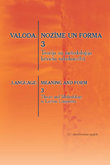Partikula SAK un modalitāte
Particle SAK ‘that is to say’ and modality
Author(s): Liene KalvišaSubject(s): Language and Literature Studies, Theoretical Linguistics, Baltic Languages
Published by: Latvijas Universitātes Akadēmiskais apgāds
Keywords: partikulas; epistēmiskā modalitāte; evidencialitāte; teksta autors; domu piedēvējums; darbības vārda semantika;
Summary/Abstract: The main function of particles in Latvian is the expression of the epistemic modality. However, some particles can be associated with evidential meaning depending mostly on the context and speech situation. The analysis of particles as evidential markers is topical and problematic issue in Latvian because of the intersection of notions of evidentiality and epistemic modality. One of the most complicated questions that scholars of evidentiality are faced with is the relation between the evidentiality (marking of the source of information of the statement) and epistemic modality (the degree of confidence the speaker has for his statement). The connection between particles and marking of evidentiality rather depends on context and is of secondary importance in Latvian. Consequently, the focus is on the content of the utterance, emphasizing the indirect nature of the information or the speaker’s attitude to the proposition.This article pays attention to the analysis of the Latvian particle sak ‘that is to say’ and its modal functions in different statements. Sak can introduce the speaker’s own words (previously uttered), as well as verbalized thoughts or gestures. The main semantic component shared by this particle is a way the speaker interprets some pre-existent situation of what was perceived by the speaker. Particle sak semantically is very close to verb form sacīt ‘to say’ and every statement includes both the semantics of verb and the modality of particle. Statements with the particle sak usually express epistemic modality or some way of coexistence of epistemic modality and evidentiality.
Journal: Valoda: nozīme un forma
- Issue Year: 2013
- Issue No: 3
- Page Range: 67-74
- Page Count: 8
- Language: Latvian

